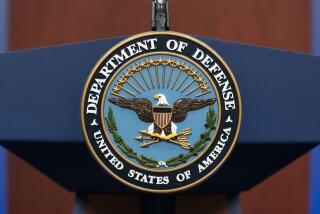U.S. military equipment to go to allies
- Share via
Reporting from Istanbul, Turkey — The United States on Friday promised allies armored vehicles and technology meant to protect against roadside bombs, an offer officials hope will entice those nations to step up their contributions to the war in Afghanistan.
Defense Secretary Robert M. Gates said the U.S. would provide heavily armored mine resistant ambush protected trucks, known as MRAPs, to allies conducting operations in violent areas of Afghanistan.
“They have saved thousands of limbs and lives in Iraq and Afghanistan,” Gates said. “The United States now will do whatever it can . . . and as soon as we can to provide surplus MRAPs to allies.”
In addition to the armored trucks, the U.S. is to provide route-clearing robots, ground-penetrating radar and other mine detection equipment. Officials also said the U.S. would send experts to train allied troops before they deploy and would step up intelligence sharing in Afghanistan, including access to classified databases that previously had been restricted.
Anders Fogh Rasmussen, secretary-general of the North Atlantic Treaty Organization, said he hoped the offer would persuade countries to send more trainers.
The U.S. and NATO are seeking about 4,000 additional trainers to help with the Afghan mission. Most of the troops would be used to mentor Afghan forces in the field, though about 1,300 of them would staff training centers and provide classroom instruction.
“Our efforts to counter IEDs are important. It is the main killer of soldiers,” Rasmussen said, referring to improvised explosive devices, or roadside bombs.
Officials have been pleased with some countries’ responses to the U.S. and NATO requests for help. Germany last week pledged about 850 additional troops, including about 500 trainers. Romania has pledged 600 additional troops.
“Everybody understands the centrality of trainers,” said a senior U.S. official this week. “The strategic effort of 2010 is to build up a credible Afghan national security force.”
But the recruitment effort was dealt a blow Friday with France’s decision to send only a small number of additional troops. French Defense Minister Herve Morin told reporters that France would provide 80 additional trainers.
U.S. officials did not immediately comment on the French announcement, saying only that during the formal meeting Morin did not mention a specific number.
“Nothing has been communicated to us other than what we heard in Istanbul today, and that was a willingness to send additional forces,” said a U.S. official.
Gates is due to travel to Paris next week and may press President Nicolas Sarkozy to increase his pledge.
The armored trucks being provided to NATO and other allies fighting in Afghanistan are the heavier original models that were used in Iraq. With the troop draw-down there, the U.S. has surplus trucks that can be donated, lent or sold to allies.
The U.S. is trying to step up production of a lighter off-road version of the MRAP called the MATV. These will not be given to allies, because the U.S. still doesn’t have enough for its own troops, U.S. officials said.
Gates said some of the original MRAPs would be sold to allies and others lent. He did not announce a precise size for the program but said the cost to U.S. taxpayers would “not be gigantic.”
Overall, officials said, the number of armored trucks to be provided is in the hundreds. There are 8,543 MRAPs in Iraq. An additional 2,224 are in Kuwait, Qatar and Bahrain.
In Afghanistan there are 4,170 MRAPs. About 800 MATVs have been delivered to the Defense Department, and 407 of those are in the field in Afghanistan.
More to Read
Sign up for Essential California
The most important California stories and recommendations in your inbox every morning.
You may occasionally receive promotional content from the Los Angeles Times.













